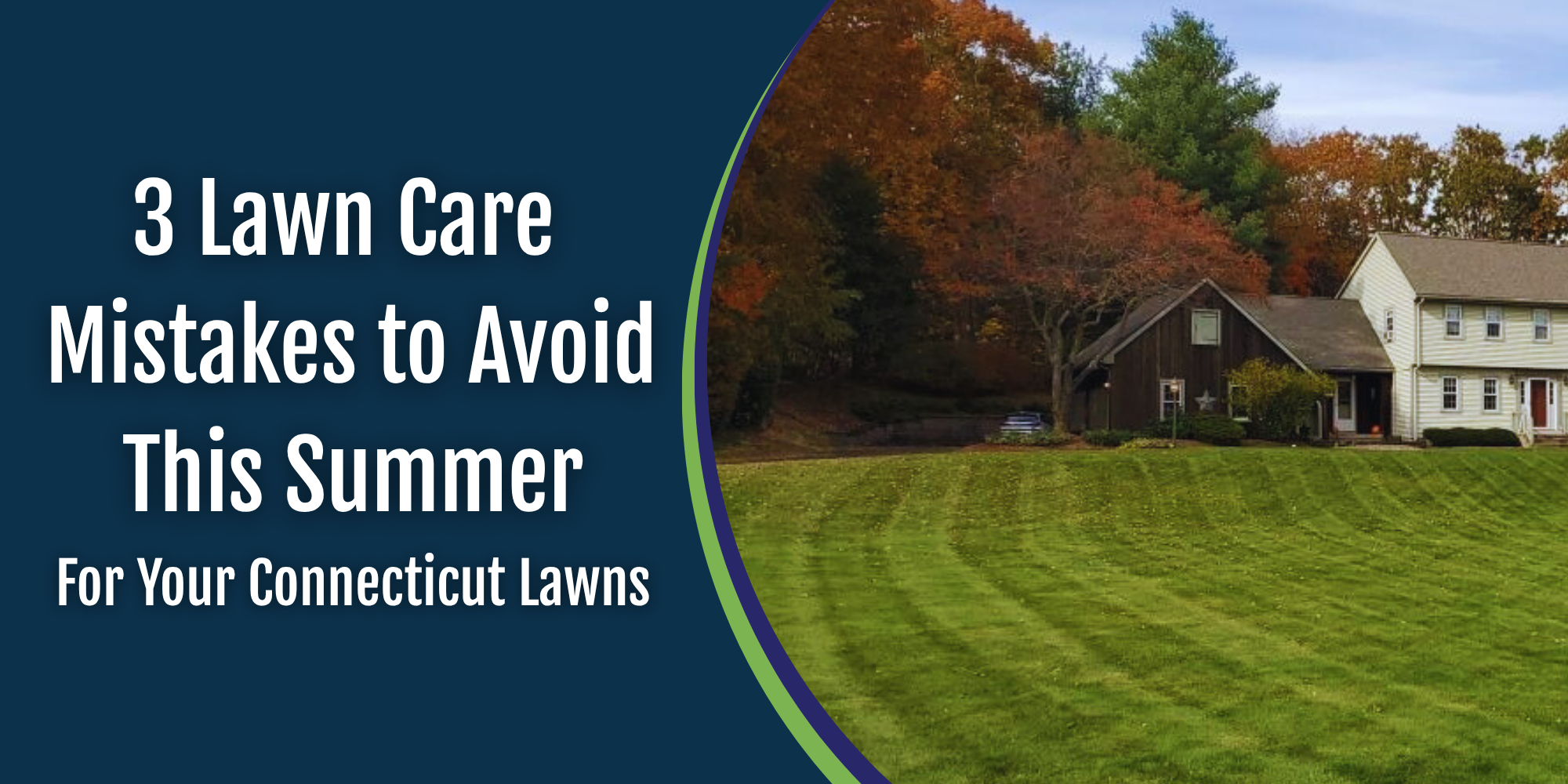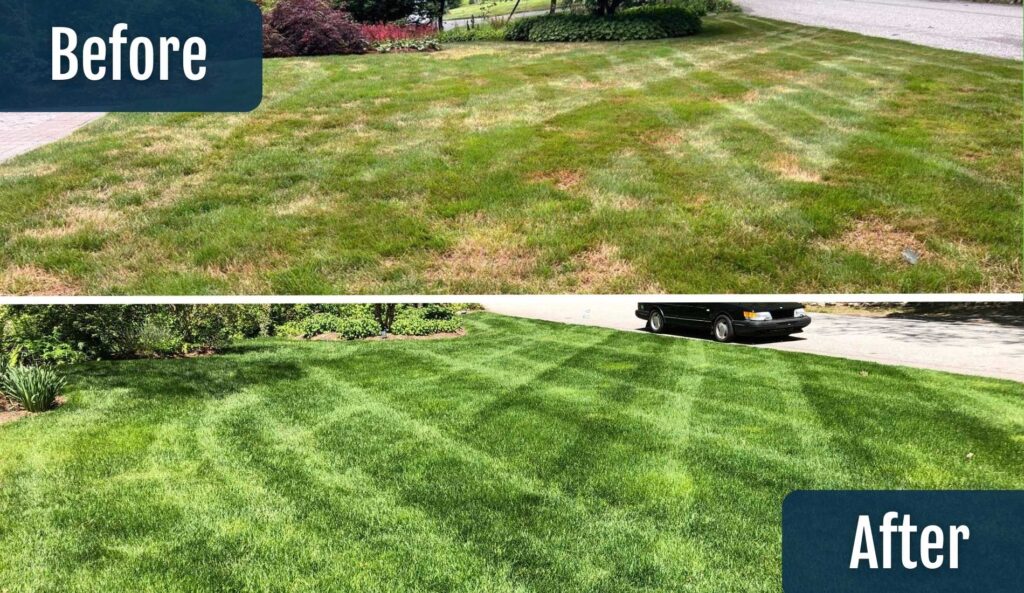
3 Lawn Care Mistakes to Avoid This Summer For Your Connecticut Lawns
After working with more than 3,000 customers, I’ve seen just about every lawn care challenge you can imagine. With over 41 years of providing lawn care for Eastern Connecticut homeowners, I’ve learned that summer is when most homeowners make mistakes that can seriously damage their lawns.
Check out our channel for more lawn care advice specifically for Eastern Connecticut homeowners. Today, I want to share the three biggest summer lawn care mistakes I see homeowners make year after year, and more importantly, how you can avoid them to keep your lawn healthy through our hot, humid Connecticut summers.
Mistake #1: Applying Grub Control at the Wrong Time
This is probably the biggest mistake I see, and it costs homeowners hundreds of dollars in lawn damage every year. Most folks think they should put down grub control in May when they see it at the garden center, but that’s actually too early for our Connecticut climate.
Here’s what most people don’t understand: grubs hatch in early to mid-August here in Connecticut. If you put down products like Merit or Grub X back in May, those products are already worn out by the time the grubs actually show up. It’s like taking an umbrella to work in the morning when it’s supposed to rain at dinner time – you’re not protected when you actually need it.
I’ve been working with the University of Connecticut soil testing labs for decades (we’re actually their biggest customer), and their research shows that timing is everything with grub control. You want to get your grub control down either right before the hatch or within a couple weeks after. That means late July through early August is your sweet spot.
Now, if you want season-long protection, there are products like Acelepryn that last longer, but for most homeowners using store-bought products, stick to that August timeline. Trust me, I’ve seen too many lawns get destroyed by grubs because folks thought they were being proactive by applying control too early.

Mistake #2: Ignoring Your Soil’s pH Level
This one might surprise you, but not testing your soil pH is setting yourself up for failure, especially here in Connecticut where our soils tend to be acidic. I can’t tell you how many customers come to me frustrated because they’re dumping fertilizer on their lawn and it’s still not growing right.
Here’s the thing about Connecticut soils – most of them are naturally acidic, meaning they have a low pH. Grass, especially the bluegrass varieties we grow here, really struggles when the pH drops below 5.5. It’s like trying to grow plants in sour soil – they just can’t take up nutrients properly no matter how much fertilizer you throw at them.
At our company, we soil test every single lawn because we’ve learned over 41 years that you can’t just guess at what your lawn needs. The ideal pH for our area is around 6.2 – that’s what we call “sweet” soil where grass can actually use the nutrients you’re giving it.
I’ve seen lawns transform completely just by getting the pH right with proper lime applications. One customer in Madison had been fighting with thin, yellow grass for years. We did a soil test, found the pH was 4.2 (way too acidic), applied lime to bring it up to 6.2, and within one season his lawn was the envy of the neighborhood.
The University of Connecticut soil testing lab does great work, and I recommend getting your soil tested every couple of years. It’s a small investment that can save you a lot of frustration and wasted money on fertilizers that aren’t working.
Mistake #3: Letting Bare Spots Turn Into Weed Factories
This is where I see homeowners shoot themselves in the foot every summer. You’ve got these bare or thin spots in your lawn, and instead of addressing them, you just hope they’ll fill in on their own. Well, nature abhors a vacuum, and those spots are going to get filled – but not with grass.
What moves into those bare spots? Crabgrass, purslane, spurge, and all kinds of weeds that love our Connecticut summers. Once those weeds get established, you’re fighting an uphill battle because they’re aggressive and they spread fast.
Here’s what we do for our customers: we identify those thin areas and plan for slice seeding, usually in late summer or early fall. A thick, healthy lawn is your best defense against weeds – it’s like having a good security system. When your grass is dense and healthy, weeds simply can’t get a foothold.
I always tell folks that every bare spot you see now is a future weed problem if you don’t address it. We use quality bluegrass blends that are suited for our climate, and the key is consistent but not excessive watering. New grass seed just needs to stay moist – about 15-20 minutes of watering daily is usually perfect.

Why These Mistakes Happen in Connecticut
Living and working in Eastern Connecticut for over four decades, I’ve seen how our unique climate creates specific challenges. Our humid summers stress lawns differently than drier climates. Our acidic soils require different approaches than alkaline soils you might find out west. And our specific grub species and weed pressures are different from what you’d deal with in other parts of the country.
That’s why generic lawn care advice you find online often doesn’t work here. We’re not just applying cookie-cutter solutions – we’re using water-based, eco-friendly treatments that are specifically designed for Connecticut conditions and tested right here in our area.
The Right Way to Handle Summer Lawn Care
Instead of making these mistakes, here’s what you should focus on this summer:
Timing is everything. Get your grub control down in late July or early August, not spring. Plan your seeding for late summer when conditions are better for germination.
Know your soil. Get a proper soil test and adjust your pH if needed. It’s the foundation of everything else you do.
Think prevention. Address bare spots before they become weed problems. A thick, healthy lawn is your best defense against weeds, diseases, and insects.
Why We Take a Different Approach
Over the years, we’ve built our reputation on not just treating the symptoms, but actually improving soil health for long-term results. That’s why 90% of our customers stick with us year after year, and why 40% of our new business comes from referrals.
We use precise, edge-to-edge applications with our water-based products that are safe for families and pets. Once they’re dry – usually within an hour or two – your family can get right back to enjoying the lawn.
Our approach focuses on building soil health with compost-based fertilizers rather than just hitting your lawn with quick-release chemicals that green it up for a few weeks. It’s like the difference between eating a balanced meal versus grabbing a candy bar – one gives you sustained energy, the other just gives you a quick spike followed by a crash.
Get Your Lawn Back on Track
Summer is more than halfway over, but there’s still time to avoid these mistakes and set your lawn up for success this fall. Fall is actually the best time for major improvements – soil amendments, seeding, and preparing your lawn for next year’s growing season.
If you’re dealing with any of these issues or just want to make sure you’re on the right track, don’t hesitate to reach out. We’ve been serving Eastern Connecticut communities like Madison, Norwich, Franklin, and surrounding areas for over 41 years, and we’d be happy to help you create the lawn you’ve always wanted.
Contact us at (860) 642-9966, get a free quote on our website, or email us at [email protected]. You can also connect with us on Facebook at American Landscape and Lawn Science. Send us a private message or respond to one of our posts, and we’ll be glad to help you avoid these costly summer lawn care mistakes.
Remember, the right approach now will give you a healthier, more beautiful lawn that you and your family can enjoy for years to come.

